Royal city in Poland
In the history of Poland, a royal city or royal town (Polish: miasto królewskie) was an urban settlement within the crown lands (Polish: królewszczyzna).[1]
The most influential royal cities enjoyed voting rights during the free election period in Poland (1572-1791). These cities were Gdańsk, Warsaw, Kraków, Poznań, Lviv, Vilnius, Toruń, Lublin, Kamianets and Elbląg. Other important royal cities included Gniezno (ecclesiastical capital of Poland and former capital of early medieval Poland), Płock (former capital of medieval Poland), Grodno (general sejm location alongside Warsaw), Bydgoszcz and Piotrków (Crown Tribunal locations alongside Lublin).
Law on the Cities
On April 18, 1791, the Great Sejm adopted the Free Royal Cities Act (full title: "Miasta nasze królewskie wolne w państwach Rzeczypospolitej" - "Our Free Royal Cities in the States of the Commonwealth"), included as Article III into the Constitution of May 3, 1791.
The law granted a number of privileges for the residents of royal cities. Many of these privileges and rights have already been enjoyed by major royal cities, and the law effectively equalized all royal cities in this respect. It also includes some rights earlier enjoyed only by szlachta.
Royal cities by region

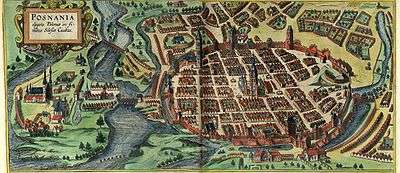
Greater Poland Province


- Babimost
- Bielsk
- Błonie
- Bolesławiec
- Bolimów
- Brdów
- Brodnica
- Brześć Kujawski
- Budzyń
- Bydgoszcz
- Chorzele
- Ciechanów
- Czersk
- Człopa
- Dąbie
- Dąbrowice
- Dobrzyń nad Wisłą
- Elbląg
- Garwolin
- Gąbin
- Gdańsk
- Gniezno
- Gostynin
- Goszczyn
- Grabów
- Grabów nad Prosną
- Grójec
- Inowłódz
- Inowrocław
- Janowo
- Kalisz
- Kamieńczyk
- Kamion
- Kcynia
- Kłecko
- Kłodawa
- Kolno
- Koło
- Konin
- Kopanica
- Kościan
- Kowal
- Kowalewo Pomorskie
- Latowicz
- Liw
- Łęczyca
- Łomża
- Maków Mazowiecki
- Mikstat
- Mława
- Mszczonów
- Nakło nad Notecią
- Nieszawa
- Nowa Brzeźnica
- Nowogród
- Nur
- Oborniki
- Odolanów
- Osieck
- Osmolin
- Ostrołęka
- Ostrów
- Ostrzeszów
- Pajęczno
- Piaseczno
- Piła
- Piotrków
- Płock
- Płońsk
- Pobiedziska
- Poznań
- Przasnysz
- Przedecz
- Pyzdry
- Radomsko
- Radziejów
- Radziłów
- Rawa
- Rogoźno
- Różan
- Rypin
- Serock
- Sieradz
- Skwierzyna
- Sochaczew
- Sochocin
- Solec
- Sompolno
- Stanisławów
- Stawiszyn
- Sulmierzyce
- Szadek
- Szczerców
- Śrem
- Środa Wielkopolska
- Toruń
- Tuszyn
- Wałcz
- Warka
- Warsaw
- Warsaw New Town
- Warta
- Wąsosz
- Wieluń
- Wiskitki
- Wizna
- Wschowa
- Wyszogród
- Zakroczym
- Zambrów
- Zgierz
Lesser Poland Province
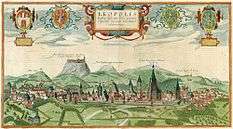
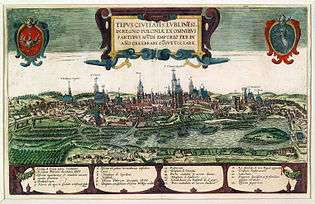
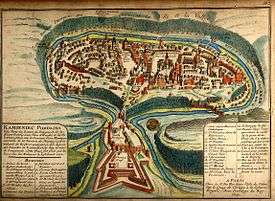




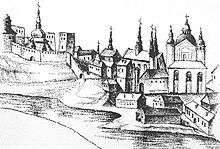
- Augustów
- Bar (today part of Ukraine)
- Belz (today part of Ukraine)
- Berezan (today part of Ukraine)
- Będzin
- Bila Tserkva (today part of Ukraine)
- Biecz
- Bielsk
- Bobrovytsia (today part of Ukraine)
- Bohuslav (today part of Ukraine)
- Bracław (today part of Ukraine)
- Brańsk
- Busk (today part of Ukraine)
- Chełm
- Chęciny
- Chmielnik
- Khmilnyk (today part of Ukraine)
- Chyhyryn (today part of Ukraine)
- Cherkasy (today part of Ukraine)
- Chervonohorod (today part of Ukraine)
- Częstochowa
- Dobrotvir (today part of Ukraine)
- Drohiczyn
- Dubienka
- Goniądz
- Grabowiec
- Grybów
- Haisyn (today part of Ukraine)
- Horodło
- Yahotyn (today part of Ukraine)
- Yaltushkiv (today part of Ukraine)
- Kamianets-Podilskyi (today part of Ukraine)
- Kaniv (today part of Ukraine)
- Kazimierz
- Kazimierz Dolny
- Kęty
- Kiev (today part of Ukraine)
- Kleparz
- Kleszczele
- Kłobuck
- Knyszyn
- Korsun (today part of Ukraine)
- Koszyce
- Kovel (today part of Ukraine)
- Kozienice
- Kraków
- Krasnystaw
- Kremenets (today part of Ukraine)
- Krzepice
- Lanckorona
- Letychiv (today part of Ukraine)
- Lelów
- Leżajsk
- Lityn (today part of Ukraine)
- Lubaczów
- Liubech (today part of Ukraine)
- Lublin
- Liuboml (today part of Ukraine)
- Lviv (today part of Ukraine)
- Łosice
- Lutsk (today part of Ukraine)
- Łuków
- Małogoszcz
- Mielnik
- Mostyska (today part of Ukraine)
- Mylianovychi (today part of Ukraine)
- Myrhorod (today part of Ukraine)
- Narew
- Nova Ushytsia (today part of Ukraine)
- Nowy Korczyn
- Nowy Sącz
- Nowy Targ
- Olkusz
- Olsztyn
- Opoczno
- Oster (today part of Ukraine)
- Oświęcim
- Ovruch (today part of Ukraine)
- Parczew
- Pereiaslav (today part of Ukraine)
- Pierzchnica
- Pilzno
- Piwniczna
- Podgórze
- Połaniec
- Potelych (today part of Ukraine)
- Proskuriv (today part of Ukraine)
- Proszowice
- Przedbórz
- Przemyśl
- Radom
- Radoszyce
- Rajgród
- Ratne (today part of Ukraine)
- Rohatyn (today part of Ukraine)
- Ropczyce
- Sambir (today part of Ukraine)
- Sandomierz
- Sanok
- Shchurovychi (today part of Ukraine)
- Słomniki
- Smotrych (today part of Ukraine)
- Sokal (today part of Ukraine)
- Solec nad Wisłą
- Stebliv (today part of Ukraine)
- Stężyca
- Stopnica
- Stoianiv (today part of Ukraine)
- Staryi Sambir (today part of Ukraine)
- Stryi (today part of Ukraine)
- Suraż
- Svunyukhi (today part of Ukraine)
- Szydłów
- Trakhtemyriv (today part of Ukraine)
- Tykocin
- Tymbark
- Tyszowce
- Ulaniv (today part of Ukraine)
- Urzędów
- Uście Solne
- Velyki Mosty (today part of Ukraine)
- Vinnytsia (today part of Ukraine)
- Volodymyr-Volynskyi (today part of Ukraine)
- Vyshnivka (today part of Ukraine)
- Wąwolnica
- Wieliczka
- Wiślica
- Wolbrom
- Zbuczyn
- Zhydachiv (today part of Ukraine)
- Zhytomyr (today part of Ukraine)
- Zvenyhorodka (today part of Ukraine)
- Zwoleń
Grand Duchy of Lithuania
.jpg)
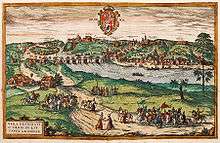
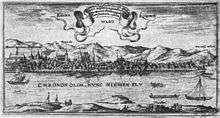
_(4).jpg)

.jpg)
- Adelsk (today part of Belarus)
- Astryna (today part of Belarus)
- Azarychy (today part of Belarus)
- Azyory (today part of Belarus)
- Berżniki (today part of Poland)
- Babruysk (today part of Belarus)
- Braslaw (today part of Belarus)
- Brest (today part of Belarus)
- Chachersk (today part of Belarus)
- Chavusy (today part of Belarus)
- Cherykaw (today part of Belarus)
- Druskininkai (today part of Lithuania)
- Drysa (today part of Belarus)
- Drysvyaty (today part of Belarus)
- Dyvin (today part of Belarus)
- Dzisna (today part of Belarus)
- Eišiškės (today part of Lithuania)
- Filipów (today part of Poland)
- Gomel (today part of Belarus)
- Grodno (today part of Belarus)
- Haradnaya (today part of Belarus)
- Hieraniony (today part of Belarus)
- Hozha (today part of Belarus)
- Jałówka (today part of Poland)
- Janów (today part of Poland)
- Jeleniewo (today part of Poland)
- Jurbarkas (today part of Lithuania)
- Kalinkavichy (today part of Belarus)
- Kamyenyets (today part of Belarus)
- Kaunas (today part of Lithuania)
- Khotsimsk (today part of Belarus)
- Kletsk (today part of Belarus)
- Klichaw (today part of Belarus)
- Kobryn (today part of Belarus)
- Korycin (today part of Poland)
- Krasnapollye (today part of Belarus)
- Krasnopol (today part of Poland)
- Krynki (today part of Poland)
- Krychaw (today part of Belarus)
- Lahishyn (today part of Belarus)
- Lazdijai (today part of Lithuania)
- Lida (today part of Belarus)
- Lipnishki (today part of Belarus)
- Lunna (today part of Belarus)
- Łomazy (today part of Poland)
- Malyech (today part of Belarus)
- Masty (today part of Belarus)
- Mazyr (today part of Belarus)
- Milejczyce (today part of Poland)
- Minsk (today part of Belarus)
- Mogilev (today part of Belarus)
- Motal (today part of Belarus)
- Mstsibava (today part of Belarus)
- Mstsislaw (today part of Belarus)
- Myadzyel (today part of Belarus)
- Novy Dvor (today part of Belarus)
- Opsa (today part of Belarus)
- Orsha (today part of Belarus)
- Parychy (today part of Belarus)
- Pinsk (today part of Belarus)
- Piszczac (today part of Poland)
- Polotsk (today part of Belarus)
- Porazava (today part of Belarus)
- Prapoysk (today part of Belarus)
- Pruzhany (today part of Belarus)
- Przerośl (today part of Poland)
- Pyerabroddzye (today part of Belarus)
- Pryvalki (today part of Belarus)
- Radashkovichy (today part of Belarus)
- Radun (today part of Belarus)
- Rahachow (today part of Belarus)
- Rechytsa (today part of Belarus)
- Sharashova (today part of Belarus)
- Skidzyel’ (today part of Belarus)
- Sokółka (today part of Poland)
- Suchowola (today part of Poland)
- Surazh, Vitebsk Voivodeship (today part of Belarus)
- Szczebra (today part of Poland)
- Šventoji (today part of Lithuania)
- Traby (today part of Belarus)
- Trakai (today part of Lithuania)
- Usvyaty (today part of Russia)
- Vasilishki (today part of Belarus)
- Vawkavysk (today part of Belarus)
- Velizh (today part of Russia)
- Vilniaus (today part of Lithuania)
- Virbalis (today part of Lithuania)
- Vištytis (today part of Lithuania)
- Vitebsk (today part of Belarus)
- Vladislavovas (today part of Lithuania)
- Voupa (today part of Belarus)
- Wasilków (today part of Poland)
- Wiżajny (today part of Poland)
- Wohyń (today part of Poland)
Royal castles and residences
Examples of Polish royal castles and residences found in former royal cities of Poland:
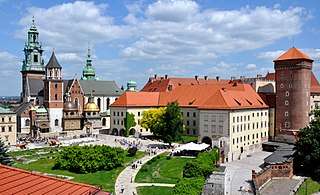
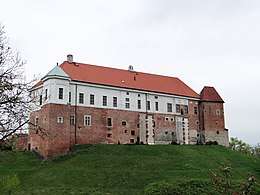
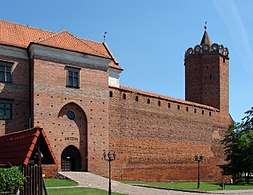
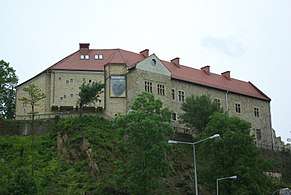
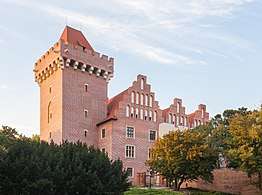
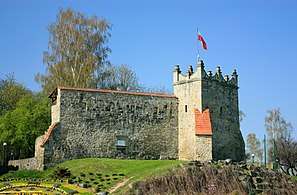 Remainings of the Royal Castle, Nowy Sącz
Remainings of the Royal Castle, Nowy Sącz Remainings of the Royal Castle, Olsztyn
Remainings of the Royal Castle, Olsztyn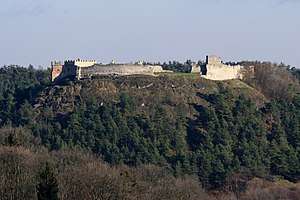 Remainings of the Royal Castle, Kremenets
Remainings of the Royal Castle, Kremenets.jpg)

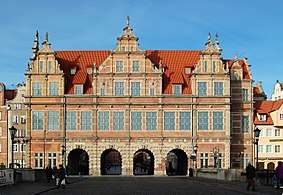
Old towns
Examples of Polish royal cities historic centers include:
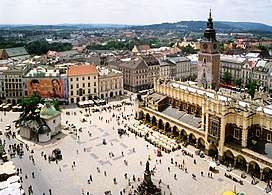
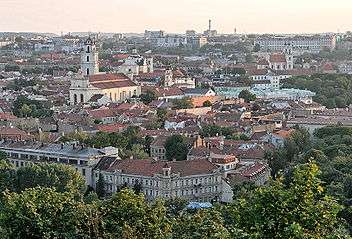
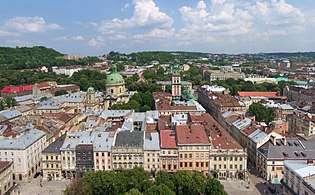
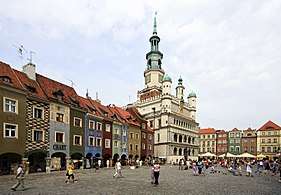
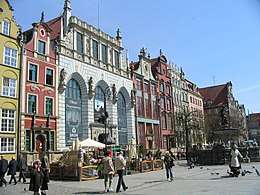
 Bydgoszcz Old Town
Bydgoszcz Old Town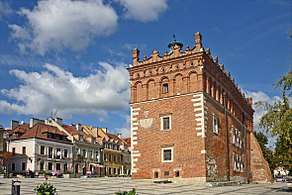 Sandomierz Old Town
Sandomierz Old Town
See also
- Royal burgh
- Royal town (disambiguation)
- Royal free city, Hungary